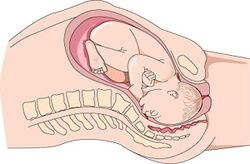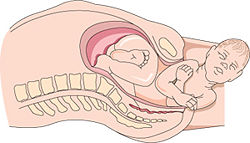Childbirth: Difference between revisions
imported>Howard C. Berkowitz No edit summary |
imported>Howard C. Berkowitz |
||
| Line 12: | Line 12: | ||
A variety of factors go into the decision to induce vaginal delivery or to perform caesarian section. | A variety of factors go into the decision to induce vaginal delivery or to perform caesarian section. | ||
==Vaginal delivery== | ==Vaginal delivery== | ||
In uncomplicated deliveries, there are a wide range of options about the birth experience. It may be in the home, it may be in a minimally clinical "birthing center", or it may be in a fully equipped labor and delivery suite. | |||
Some mothers prefer "natural childbirth" with no drugs for pain control, routine intravenous lines, or fetal monitoring. Others want more medical support. Pain control is complex, because a number of drugs that make the mother more comfortable also depress the respiration of the baby or the muscular tone needed for delivery. | |||
===First stage of labor=== | ===First stage of labor=== | ||
{{Image|Labor-pelvis.jpg|left|250px|Most babies enter the [[birth canal]] facing sideways and the head turns face down.}} | {{Image|Labor-pelvis.jpg|left|250px|Most babies enter the [[birth canal]] facing sideways and the head turns face down.}} | ||
| Line 34: | Line 37: | ||
===Third stage of labor=== | ===Third stage of labor=== | ||
The [[placenta]] is delivered during the third stage of labor. Usually this phase of labor takes between 5 to 20 minutes. | The [[placenta]] is delivered during the third stage of labor. Usually this phase of labor takes between 5 to 20 minutes. | ||
== Cesarean section == | == Cesarean section == | ||
The cesarean is when a baby is surgically removed from the uterus. Most cesarean section usually takes up to an hour to complete. The surgeon normally makes two cuts in the lower abdomen before making an incision in the uterus. The baby is removed from the uterus and the umbilical cord is cut. | The cesarean is when a baby is surgically removed from the uterus. Most cesarean section usually takes up to an hour to complete. The surgeon normally makes two cuts in the lower abdomen before making an incision in the uterus. The baby is removed from the uterus and the umbilical cord is cut. | ||
==References== | ==References== | ||
{{reflist}} | {{reflist}} | ||
Revision as of 19:20, 3 August 2010
Childbirth, or labor and delivery, is the process by which a woman gives birth to a baby. Standard Western practice divides the process into three named stages. The first stage of labor involves cervical dilation and has two phases: latent and active. The second stage of labor is the period from the descent of the baby to its actual birth, while the third stage of childbirth is when the placenta is delivered.
Childbirth is accompanied by severe pain and attendant anxiety. The woman in labor generally experiences a wide range of complex and intense emotions
Assessment
Ideally, the person performing the delivery -- a physician or midwife -- has access to prenatal sonograms, laboratory tests, etc. In any event, an experienced operator will palpate the uterus to find the position of the fetus. Vaginal examination will reveal potentially catastrophic complications such as placenta previa,
Station
Station is measured by where the baby's head is located in reference to the woman's ischial spines. Measurements above the ischial spines are reported as -1 to -5. Once the baby's head engages into the pelvis, or at 0 station, the baby's placement within the birth canal will be written in positive numbers. The numbers for the positive station are written as +1 to +5.
Decisions about delivery
A variety of factors go into the decision to induce vaginal delivery or to perform caesarian section.
Vaginal delivery
In uncomplicated deliveries, there are a wide range of options about the birth experience. It may be in the home, it may be in a minimally clinical "birthing center", or it may be in a fully equipped labor and delivery suite.
Some mothers prefer "natural childbirth" with no drugs for pain control, routine intravenous lines, or fetal monitoring. Others want more medical support. Pain control is complex, because a number of drugs that make the mother more comfortable also depress the respiration of the baby or the muscular tone needed for delivery.
First stage of labor

Most babies enter the birth canal facing sideways and the head turns face down.
Triggered by the hormone oxytocin, produced in the pituitary gland, irregular contractions are felt during the latent phase of labor. The contractions will slowly become more regular and pain is minimal. The cervix will dilate and efface up to 4 centimeters during the latent phase of labor. First time mothers will on average labor 8 hours during the latent phase. Mothers who have borne previous children typically have shorter labor during the latent phase. Towards the end of this stage a woman will enter the transition phase. During this part of labor the cervix will continue to dilate to 10 centimeters. This is probably the most painful part of the labor process.
Cervical dilation
Measurement of the cervix is recorded from 0 to 10 centimeters. The cervix is considered complete when it reaches 10 centimeters.
The cervix shortens in preparation for birth. The normal uneffaced average cervical length is between 3.5 to 4.0 centimeters.
Fetal monitoring
Delaying the first stage
If a birth is premature or there are medical reasons to delay vaginal delivery, tocolytic drugs may be used to suppress uterine contractions. Current agents used to delay premature uterine activity include magnesium sulfate, oxytocin antagonists, calcium channel inhibitors, and adrenergic beta-receptor agonists. Ethyl alcohol is obsolete for tocolysis.
Second stage of labor
The cervix is fully dilated and the woman begins to push to deliver the baby. This phase of labor can last up to two hours. The baby is delivered at the end of the second stage of labor. The umbilical cord is cut by the doctor once the delivery is finished.
Episiotomy
A small incision, or cut, used to enlarge the vaginal opening. The cut is made from the vaginal to anus. The person performing the delivery sutures the area once the delivery is finished. This is not always done during a vaginal delivery, and, indeed, is quite controversial.[1]
Third stage of labor
The placenta is delivered during the third stage of labor. Usually this phase of labor takes between 5 to 20 minutes.
Cesarean section
The cesarean is when a baby is surgically removed from the uterus. Most cesarean section usually takes up to an hour to complete. The surgeon normally makes two cuts in the lower abdomen before making an incision in the uterus. The baby is removed from the uterus and the umbilical cord is cut.
